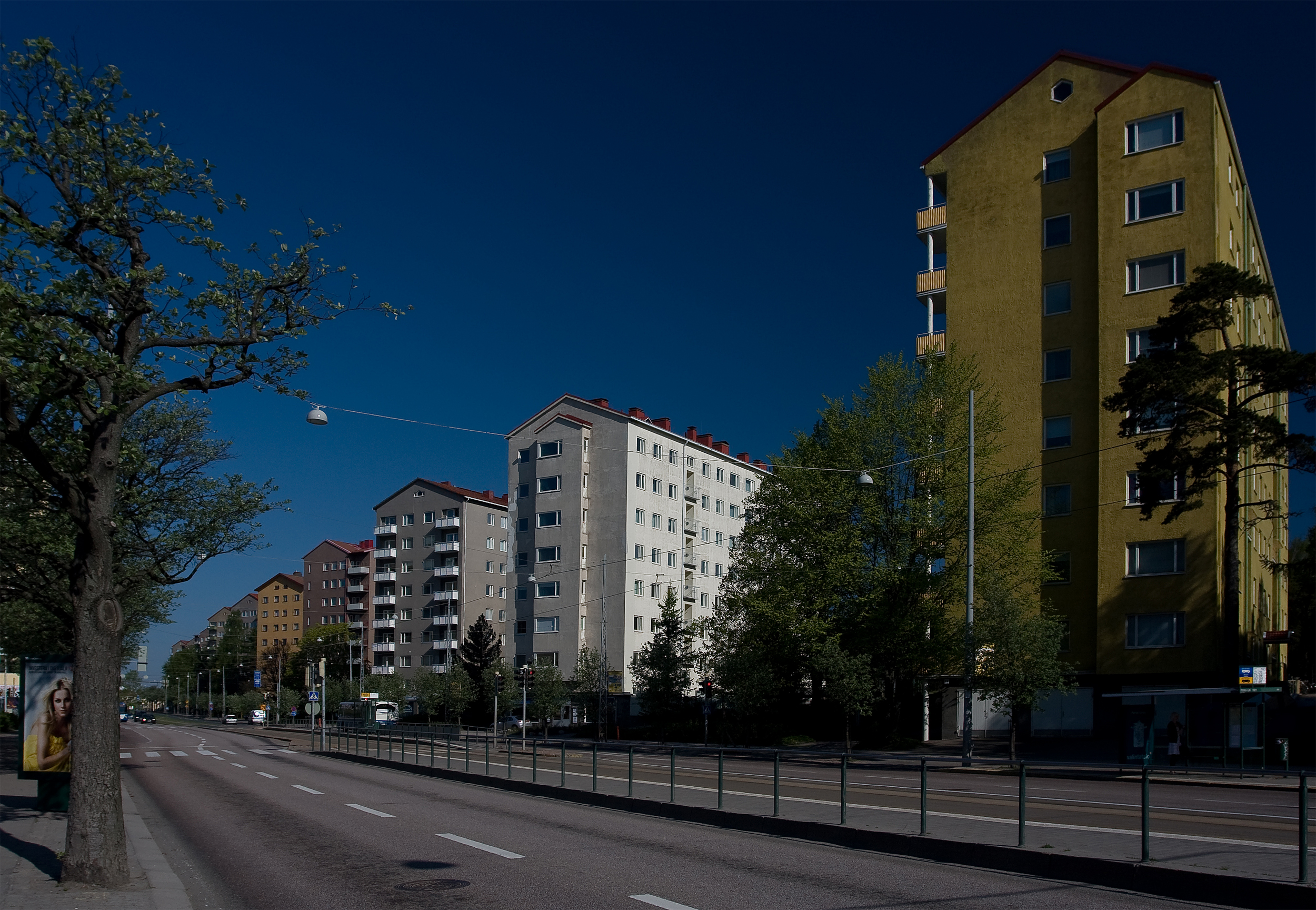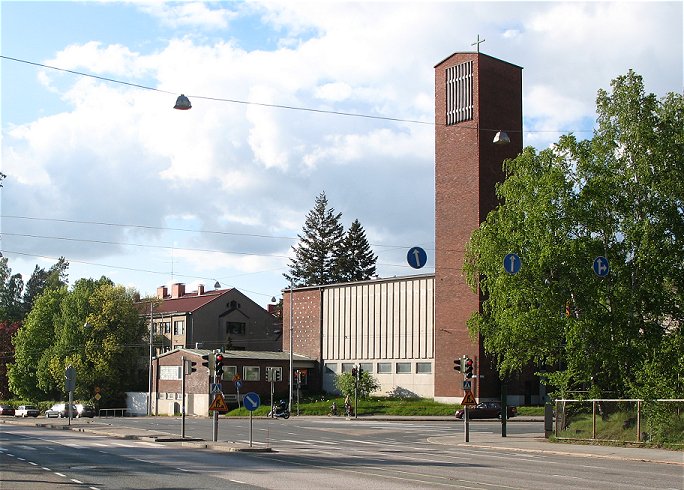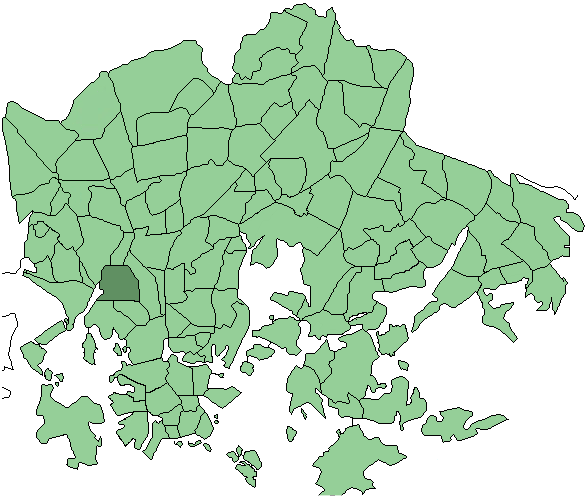|
Laakso
Laakso ( sv, Dal) is a neighbourhood in Helsinki, Finland. Its borders are defined by the streets of Mannerheimintie and Nordenskiöldinkatu and the Helsinki Central Park. The neighbourhood is bordered by Töölö in the south, Meilahti in the southwest, Ruskeasuo in the north and Länsi-Pasila in the east. The neighbourhood has an area of 0.74 km², a population of 1781 and 1583 jobs (December 31, 2003). Laakso is neighbourhood #18 in the official neighbourhood numbering of Helsinki, and belongs to the district of Reijola. The population in Laakso is mainly concentrated in multiple-floor apartment buildings on Mannerheimintie. The neighbourhood also includes a hospital, a riding field, a traffic playground, and a large part of the southern Central Park. For the 1952 Summer Olympics, the neighborhood hosted the Eventing equestrian The word equestrian is a reference to equestrianism, or horseback riding, derived from Latin ' and ', "horse". Horseback riding (or Rid ... [...More Info...] [...Related Items...] OR: [Wikipedia] [Google] [Baidu] |
Meilahti
Meilahti (in Swedish Mejlans) is a neighbourhood of Helsinki between Mannerheimintie (the main entrance road to Helsinki) and a bay named Seurasaarenselkä. Most of the houses in Meilahti were built in the 1930s and 1940s. Meilahti is home to over 6700 people. Meilahti is the location of Mäntyniemi, official residence of the President of Finland, as well as Kesäranta, the official residence of Prime Minister of Finland. Near Mäntyniemi is the former presidential residence, Tamminiemi, which is today a museum dedicated to president Urho Kekkonen. Several hospitals are located in this district, including the Meilahti Hospital of the Helsinki University Central Hospital (HUCH). Neighbourhoods surrounding Meilahti are Töölö, Munkkiniemi, Ruskeasuo, Pikku Huopalahti and Laakso. For the 1952 Summer Olympics, the neighborhood hosted the rowing Rowing is the act of propelling a human-powered watercraft using the sweeping motions of oars to displace water and gener ... [...More Info...] [...Related Items...] OR: [Wikipedia] [Google] [Baidu] |
Nordenskiöldinkatu
Nordenskiöldinkatu (Swedish: ''Nordenskiöldsgatan'') is a frequently trafficked street in Helsinki, Finland, going from Taka-Töölö to Alppila and Pasila. It was named after the explorer Adolf Erik Nordenskiöld.''Helsingin kadunnimet, Helsingin kaupungin julkaisuja nro 24'', p. 124. Name bureau of the city of Helsinki, 1970. Nordenskiöldinkatu is a continuation of Mechelininkatu. Its western end is at the Nordenskiöld square in Taka-Töölö, where Mechelininkatu ends, and which is also connected to Topeliuksenkatu and Linnankoskenkatu. Its eastern end is at a railroad underpass, after which it changes its name to Savonkatu and continues towards Itä-Pasila. Nordenskiöldinkatu is the only street to run across Mannerheimintie keeping the same name on both sides. Only the western part of Nordenskiöldinkatu has residential block houses, between the Nordenskiöld square and Urheilukatu. In this part are also located the Russian science and culture centre and the head of ... [...More Info...] [...Related Items...] OR: [Wikipedia] [Google] [Baidu] |
Mannerheimintie Laakso Helsinki
Mannerheimintie ( sv, Mannerheimvägen), named after the Finnish military leader and statesman Carl Gustaf Emil Mannerheim, is the main street and boulevard of Helsinki, Finland. It was originally named Heikinkatu ( sv, Henriksgatan), after Robert Henrik Rehbinder, but was renamed after the Winter War. The change of name was also suitable due to Mannerheim having paraded in along that road during the Finnish Civil War (1918), after German forces allied with Mannerheim's Finnish forces had retaken the city. That event is also portrayed in the landmark statue of Mannerheim sitting horseback. The statue is located along the Mannerheimintie just outside the modern arts museum Kiasma. The street starts at Erottaja in the city centre, near the Swedish Theatre and continues in a northernly direction past the Stockmann department store. It then continues as a main thoroughfare past the districts of Kamppi, Töölö, Meilahti, Laakso and Ruskeasuo, until it finally merges into a b ... [...More Info...] [...Related Items...] OR: [Wikipedia] [Google] [Baidu] |
Mannerheimintie
Mannerheimintie ( sv, Mannerheimvägen), named after the Finnish military leader and statesman Carl Gustaf Emil Mannerheim, is the main street and boulevard of Helsinki, Finland. It was originally named Heikinkatu ( sv, Henriksgatan), after Robert Henrik Rehbinder, but was renamed after the Winter War. The change of name was also suitable due to Mannerheim having paraded in along that road during the Finnish Civil War (1918), after German forces allied with Mannerheim's Finnish forces had retaken the city. That event is also portrayed in the landmark statue of Mannerheim sitting horseback. The statue is located along the Mannerheimintie just outside the modern arts museum Kiasma. The street starts at Erottaja in the city centre, near the Swedish Theatre and continues in a northernly direction past the Stockmann department store. It then continues as a main thoroughfare past the districts of Kamppi, Töölö, Meilahti, Laakso and Ruskeasuo, until it finally merges into a busy ... [...More Info...] [...Related Items...] OR: [Wikipedia] [Google] [Baidu] |
1952 Summer Olympics
The 1952 Summer Olympics ( fi, Kesäolympialaiset 1952; sv, Olympiska sommarspelen 1952), officially known as the Games of the XV Olympiad ( fi, XV olympiadin kisat; sv, Den XV olympiadens spel) and commonly known as Helsinki 1952 ( sv, Helsingfors 1952), were an international multi-sport event held from 19 July to 3 August 1952 in Helsinki, Finland. After Japan declared in 1938 that it would be unable to host 1940 Olympics in Tokyo due to the ongoing Second Sino-Japanese War, Helsinki had been selected to host the 1940 Summer Olympics, which were then cancelled due to World War II. Tokyo eventually hosted the games in 1964. Helsinki is the northernmost city at which a summer Olympic Games have been held. With London hosting the 1948 Olympics, 1952 is the most recent time when two consecutive summer Olympics Games were held entirely in Europe. The 1952 Summer Olympics was the last of the two consecutive Olympics to be held in Northern Europe, following the 1952 Winter Olympic ... [...More Info...] [...Related Items...] OR: [Wikipedia] [Google] [Baidu] |
Venues Of The 1952 Summer Olympics
For the 1952 Summer Olympics, a total of twenty-four sports venues were used. Three of the venues were constructed for the 1940 Summer Olympics, but were postponed in the wake of World War II. Those venues were completed in time for the 1952 Games. The main stadium served as host to the World Athletics Championships in 1983 and in 2005. Two venues were purchased by the city of Helsinki after the Olympics, one changed from an exhibition center to a sports arena, and another changed from a sports arena to an art museum. With an annual average temperature of 5.9 °C, Helsinki is the coldest city to host the Summer Olympics. Venues Before the Olympics The idea for the construction of the Olympic Stadium began in 1927 though construction itself would take place between 1934 and 1938.History of Helsinki Olympic Stadium. [...More Info...] [...Related Items...] OR: [Wikipedia] [Google] [Baidu] |
Equestrian At The 1952 Summer Olympics
The equestrian events at the 1952 Helsinki Summer Olympics included dressage, eventing, and show jumping. All three disciplines had both individual and team competitions and were held from 28 July to 3 August 1952. One of the biggest changes at the 1952 Olympics was the demographics of competitors. Before this, most of the riders were officers (41 of 44 starters at the 1948 Olympics were riding in uniform), whereas the Helsinki Games saw over 50% of competitors from the civilian ranks. Additionally, women were now allowed to compete for the first time in equestrian events. At the 1952 Games, they were permitted in the dressage competition, although prohibited from the jumping (per a ruling in 1951) and most definitely not in eventing which was considered too dangerous. A total of 4 women competed out of 134 riders. 25 nations competed: Argentina, Brazil, Bulgaria, Canada, Chile, Denmark, Egypt, Finland, France, Federal Republic of Germany, Great Britain, Ireland, Italy, Japa ... [...More Info...] [...Related Items...] OR: [Wikipedia] [Google] [Baidu] |
Subdivisions Of Helsinki
The city of Helsinki, the capital of Finland, can be divided into various sorts of subdivisions. Helsinki is divided into three major areas: Helsinki Downtown ( fi, Helsingin kantakaupunki, sv, Helsingfors innerstad), North Helsinki ( fi, Pohjois-Helsinki, sv, Norra Helsingfors) and East Helsinki ( fi, Itä-Helsinki, sv, Östra Helsingfors). The subdivisions include neighbourhoods, districts, major districts and postal code areas. The plethora of different official ways to divide the city is a source of some confusion to the inhabitants, as different kinds of subdivisions often share similar or identical names. Neighbourhoods Helsinki consists of 60 neighbourhoods (''kaupunginosa'' in Finnish; ''stadsdel'' in Swedish). The division into neighbourhoods is the official division created by the city council and used for city planning and other similar purposes. Most of the neighbourhoods have existed since the 19th century as numbered parts of the city, and official names we ... [...More Info...] [...Related Items...] OR: [Wikipedia] [Google] [Baidu] |
Pasila
Pasila (; sv, Böle, ) is a part of Helsinki, Finland, that is both a central-northern neighbourhood and district, bordering the areas of Alppila to the south, the Central Park ( Keskuspuisto) to the west, and Vallila to the east. Pasila is a major transportation hub. At its heart is the Pasila railway station, the second busiest station in Finland. The station serves about 130,000 people per day via 900 trains, 400 trams and 850 buses. Central Pasila The eastern and western parts of Pasila were formerly separated by a large railroad classification yard before the development of Central Pasila ( fi, Keski-Pasila), beginning in 2014. Central Pasila is currently home to the major sports and music venue Helsinki Halli and the Tripla complex, which includes a hotel of about 430 rooms, 50,000 square metres of office space (including the headquarters of telecom operator Telia Finland), about 400 residential flats and the largest commercial center in the Nordic countries wit ... [...More Info...] [...Related Items...] OR: [Wikipedia] [Google] [Baidu] |
Töölö
Töölö (; sv, Tölö, formerly spelled ''Thölö'') is the collective name for the neighbourhoods Etu-Töölö ( sv, Främre Tölö, lit=Front Töölö, links=no) and Taka-Töölö ( sv, Bortre Tölö, lit=Rear Töölö, links=no) in Helsinki, Finland. The neighbourhoods are located next to the city centre, occupying the western side of the Helsinki Peninsula. Etu-Töölö, the southern neighbourhood, borders Kamppi and is the location of the Finnish Parliament House. Taka-Töölö, the northern neighbourhood, borders Meilahti and Laakso, and is the location of the Helsinki University Central Hospital. Contrary to popular belief, Töölö is no longer an official name of any district or neighbourhood in Helsinki; in 1959 Töölö was divided into Etu-Töölö and Taka-Töölö. Overview Töölö was built in 1920–1930 when Helsinki suffered from rapid population growth and needed more housing. It was the site of the first ever town planning competition in Finland in 189 ... [...More Info...] [...Related Items...] OR: [Wikipedia] [Google] [Baidu] |
Ruskeasuo
Ruskeasuo (Brunakärr in Swedish, verbatim "Brown swamp") is a neighbourhood of Helsinki (Helsingfors in Swedish), about 3 kilometres north of the city center. With a population of 2670 (year 2005) Ruskeasuo is a rather quiet residential area. Buildings by Mannerheimintie are typically 6-8 floors high from 1950s. Between Mannerheimintie and Central Park, low-rise buildings are dominant. The equestrian dressage and eventing competitions for the 1952 Summer Olympics The 1952 Summer Olympics ( fi, Kesäolympialaiset 1952; sv, Olympiska sommarspelen 1952), officially known as the Games of the XV Olympiad ( fi, XV olympiadin kisat; sv, Den XV olympiadens spel) and commonly known as Helsinki 1952 ( sv, Helsin ... took place at their sports hall. References1952 Summer Olympics official report.p. 58. Venues of the 1952 Summer Olympics Olympic equestrian venues {{Summer-Olympic-venue-stub ... [...More Info...] [...Related Items...] OR: [Wikipedia] [Google] [Baidu] |
Apartment Building
An apartment (American English), or flat (British English, Indian English, South African English), is a self-contained housing unit (a type of residential real estate) that occupies part of a building, generally on a single story. There are many names for these overall buildings, see below. The housing tenure of apartments also varies considerably, from large-scale public housing, to owner occupancy within what is legally a condominium ( strata title or commonhold), to tenants renting from a private landlord (see leasehold estate). Terminology The term ''apartment'' is favored in North America (although in some cities ''flat'' is used for a unit which is part of a house containing two or three units, typically one to a floor). In the UK, the term ''apartment'' is more usual in professional real estate and architectural circles where otherwise the term ''flat'' is used commonly, but not exclusively, for an apartment on a single level (hence a 'flat' apartment). In some coun ... [...More Info...] [...Related Items...] OR: [Wikipedia] [Google] [Baidu] |


.jpg)




